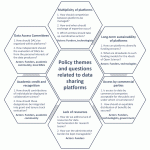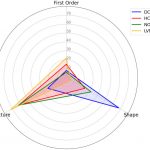
Interview with Eline Vinke
Background: Eline is a PhD Candidate at Erasmus Medical Center. Her PhD Project focuses on modelling aging trajectories of the brain as part of the EuroPOND project. Prior to this, she has been working for a couple of years as a Logistics Manager at the Technical Innovations in Medicine (TiiM) conference. She has published several articles among them the ‘’Progression along data-driven disease timelines is predictive of Alzheimer’s disease in a population-based cohort ‘’ which is the latest.
Q : Eline, please tell us about yourself.
My name is Eline Vinke, I have a background in clinical technology and have a strong interest in the translation of technology to clinical practice and medical research. I started my PhD project at the Erasmus Medical Center at the department of radiology and nuclear medicine and the department of epidemiology in 2016. My projects were focused on modelling and disentangling the broad spectrum of ‘healthy’ brain aging using longitudinal brain MRI data. This was in order to increase the knowledge of normal brain aging, to enhance the understanding of age-related neurological diseases but also models of age-related diseases such as dementia. Since 2019, I am imaging coordinator of Biobanking and BioMolecular resources Research Infrastructure Netherlands (BBMRI.nl) and I am involved in projects focussing on the development of a unified imaging data infrastructure, which supports development of biomedical imaging technologies and the dissemination of knowledge, with the ultimate goal of improving diagnosis, treatment and prevention of disease.
Q : How did you become interested in Epidemiology and Radiology?
When I started my education in clinical technology I was already interested in the translation of technology to clinical practice. My interest in specifically Epidemiology and Radiology started during my bachelor and master in clinical technology. I realized that medical imaging is one of the fields that has a lot of potential to increase our understanding of diseases and can play a big role in improving diagnosis, treatment and prevention of disease. This in combination with the fact that medical imaging is a large and rapidly growing field with a lot of challenges and technical innovations, makes the field even more interesting in my opinion.
Q : When did you get involved in the euCanSHare Project?
When I started as imaging coordinator of BBMRI.nl in April 2019, The euCanSHare Project already kicked off and I got involved in developing the euCanSHare catalogue, focussing on medical imaging metadata.
Q: Could you please describe your work in euCanSHare? Which is the best part in your work? And the most challenging one?
One of the aims of euCanSHare is to create a data platform for enhanced data sharing and big data research in cardiology. To create an environment for data sharing, it is crucial that the data on that platform is ‘FAIR’, meaning findable, accessible, interoperable and re-usable. My work in euCanSHare mainly focusses on the findable part, regarding medical imaging data, meaning that I try to describe the medical imaging data present in the cohorts in such a way that it is findable in the euCanSHare catalogue. With the large variation in imaging modalities, acquisition parameters, vendors and data analyses within the field of cardiology, harmonizing metadata describing the medical imaging collected in a cohort is a big challenge. However, since I like challenges, it is also my favourite part of my work!
Q: How is being involved in a large Horizon 2020 large collaborative research and innovation project as euCanSHare?
While being involved in such a large consortium, it is inspiring to see that there are so many people, from different parts of the world and with different backgrounds and expertise, who work together to reach one goal.
Q: What are the main challenges imaging platforms face?
Harmonization of imaging metadata is a challenge, as I explained before. However, considering not only the ‘findable’ part, but also the accessible, interoperable and re-usable part of ‘FAIR’, other harmonization challenges occur as well. Harmonizing how medical imaging data should be stored requires an infrastructure that is detailed enough to cover the broad range of medical imaging data that is out there, but should also still be workable and understandable.
Q: In which ways can we improve imaging platforms?
There are a lot of different initiatives that work on creating and improving imaging platforms. I believe that to overcome the challenges we face, it is important to work together and to learn from each other. For example, though within euCanSHare the goal is to create a data platform in the field of Cardiology, it is important to take into account solutions that are suggested outside the field of cardiology as well. This way we can work towards a more unified medical imaging infrastructure.
Q: How are imaging platforms improving citizen’s life?
The ultimate goal is to improve diagnosis, treatment and prevention of disease. I believe that a medical imaging data platform enables and supports development of biomedical imaging technologies that can achieve that.
Q: What do you think of the role of AI in imaging, particularly in diagnosis and risk assessment? Do you find any risk in the increasing use of AI as a support of radiologists’ work?
I feel that there is a lot of potential in the usage of AI to support a radiologist. To reach the full potential of AI within radiology, I believe that collaborations between biomedical engineers and clinicians is crucial. Technically there is already so much possible. However, the question is how we can use the technology to really contribute to the work of a radiologist in a safe way? I believe that only by combining the technical and clinical expertise we are able to answer that question.
Q: What are currently the new frontiers of imaging research?
In line with my previous answer, more and more technical solutions focussing on improving (early) diagnosis of disease are being developed. However, the translation to the clinical practice remains challenging. A new frontier in imaging research in my opinion is to adjust and improve the developed technologies in such a way that it contributes to clinical practice.
Q: What are your future plans?
My future plans are to continue my research in the medical imaging field. At the end of this year I am leaving my job as imaging coordinator of BBMRI.nl. I look back at some great years where I enjoyed contributing to the development of imaging data platforms, like in euCanSHare.

